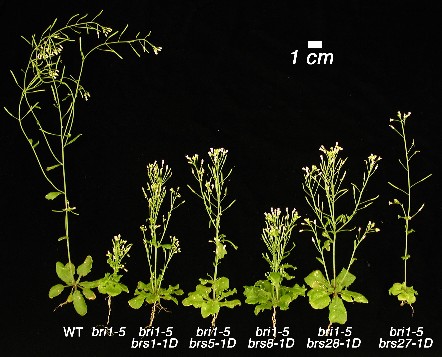Jia Li
Associate Professor, Plant Development / Plant Molecular Biology
 |
| Dr. Jia Li |
CONTACT:
Department of Botany and Microbiology
770 Van Vleet Oval
University of Oklahoma
Norman, OK 73019
Office phone: 405-325-1653
Lab phone: 405-325-3176
Fax: 405-325-7619
Email: lij@ou.edu
EDUCATION:
Postdoctoral training: University Of Missouri-Columbia, 1997-2001.
Ph.D. Virginia Polytechnic Institute and State University, 1995.
M.S. Institute of Botany, Chinese Academy of Sciences, 1989.
B.S. Department of Biology, Lanzhou University, 1984.
RESEARCH INTERESTS:
The long term goal of my research group is to understand roles of cell-surface receptor-like protein kinases (RLKs) in regulating plant growth and development, currently focusing our studies on RLK-mediated brassinosteroid (BR) signal transduction in the model plant Arabidopsis.
BRs are essential plant hormones controlling many critical processes during normal growth and development. Mutants lacking the ability to biosynthesize or to perceive BRs exhibit extremely dwarfed phenotypes, with epinastic and rounded leaves, delayed senescence, reduced male-fertility, and altered photomorphogenesis and skotomorphogenesis. BRs are perceived by a cell-surface leucine-rich repeat RLK (LRR-RLK) named BRI1. To discover novel regulatory components in the BRI1-mediated BR signaling pathway, my group has successfully employed an activation-tagging approach to identify genetic modifiers of a weak bri1 allele, bri1-5. We have carried out a large-scale activation-tagging genetic screen (> 120,000 activation-tagging lines screened) and identified more than 40 bri1-5 genetic suppressors. The tagged genes encode a variety of proteins with divergent cellular functions. Several of these proteins have been functionally characterized. The characterized proteins include BRS1 (a serine carboxypeptidase), BAK1 (an LRR-RLK distinct from BRI1), BKK2 (a BAK1-LIKE LRR-RLK), BRL1 and BRL3 (two BRI1-LIKE LRR-RLKs), and BEN1 (a DFR-LIKE putative steroid reductase). We hypothesized that BRS1 might be involved in an early proteolytic processing step in the BR signaling, BAK1 and BAK1-LIKE proteins might act as co-receptors of BRI1, BEN1 might be responsible for the homeostasis of in vivo bioactive BRs. We are currently testing these hypotheses
Most recently, my group identified that BAK1 and BKK1 are involved in the interplay of BR-dependent growth and BR-independent cell-death signaling pathways (see below). We are trying to further dissect the detailed molecular mechanisms of BAK1 and BKK1 in regulating these two antagonistic signaling pathways.
 |
| Figure 1. Current model of the BR signal transduction. Major regulators and their roles are indicated. Significant gaps still need to be filled in the future. |
 |
| Figure 2. Hypothetic functions of BAK1 and BKK1 in both growth and cell-death control signaling pathways. BAK1 and BKK1 play important roles in regulating two antagonistic signaling pathways possibly by alternating their physical interactions with BRI1 and an unknown LRR-RLK in order to initiate two divergent signaling cascades. |
AWARDED RESEARCH GRANTS:
- The National Science Foundation, Novel Components of Brassinosteroid Signaling. P.I., 2002-2006.
- NSF 2010, Functional Analysis and Phosphorylation Site Mapping of Leucine-Rich Repeat Receptor-Like Kinases in Arabidopsis. Steven Clouse (P.I., NC State), Jia Li (Co-P.I.), Steven Huber (Co-P.I., UIUC), and Michael B. Goshe (Co-P.I., NC State). 2004-2008.
- OCAST (Oklahoma Center for the Advancement of Science and Technology), Role of Serine Carboxypeptidases in Regulating Brassinosteroid Signal Transduction, P.I. 2007-2009.
COURSES TAUGHT:
- Advanced Molecular Biology and Genetics
- Plant Molecular Biology
- Principles of Plant Physiology
- Molecular Mechanisms of Plant Development
- Graduate Student Seminar
SELECTED PUBLICATIONS:
 |
| Figure 3. Using activation-tagging approach to identify key proteins mediating BR signal transduction. In this experiment, a weak mutant (bri1-5) of the BR receptor gene BRI1 was used as the genetic background. Both suppressors and enhancers were successfully obtained via this genetic method. |
- Wang, X., Kota, U., He, K., Blackburn, K., Li, J., Goshe, M.B., Huber, S.C., and Clouse, S.D. (2008). Sequential transphosphorylation of the BRI1/BAK1 receptor kinase complex impacts early events in brassinosteroid signaling. Developmental Cell 15, 220-235.
- He, K., Gou, X., Powell, R.A., Yang, H., Yuan, T., Guo, Z., and Li, J.* (2008). Receptor-like protein kinases, BAK1 and BKK1, regulate a light-dependent cell-death control pathway. Plant Signaling & Behavior 3:10, 813-815 (Invited Addendum)
- Heese, A., Hann, D.R., Gimenez-ibanex, S., Jones, A., He, K., Li, J., Schroeder, J.I., Peck, S.C., Rathjen, J.P. (2007) The receptor-like kinase SERK3/BAK1 is a central regulator of innate immunity in plants. Proc. Natl. Acad. Sci. USA 104, 12217-12222.
- He, K., Gou, X., Yuan, T., Lin, H., Asami, T., Yoshida, S., Russell, S.D., Li, J. * (2007) BAK1 and BKK1 regulate brassinosteroid-dependent growth and brassinosteroid-independent cell death pathways. Current Biology 17, 1109-1115.
- Yuan, T., Fujioka, S., Takatsuto, S., Matsumoto, S., Gou, X.,He, K., Russell, S.D., and Li, J.* (2007) BEN1, a gene encoding a dihydroflavonol 4-reductase (DFR)-like protein, regulates the levels of brassinosteroids in Arabidopsis thaliana. Plant Journal 51(2), 220-233.
- Li, J.* and Gou, X. (2007) Brassinosteroids. In: Encyclopedia of Life Sciences. John Wiley & Sons, Ltd: Chichester http://www.els.net/ [DOI: 10.1002/9780470015902.a0020092]
- Wang, L., Xu, Y.Y., Li, J.*, Xu, Z.H., and Chong, K*. (2007) Transgenic rice plants ectopically expressing AtBAK1 are semi-dwarfed and hypersensitive to 24-epibrassinolide. Journal of Plant Physiology 164(5), 655-664. (*co-corresponding authors).
- Zhou, A. and Li, J.*. (2005). Arabidopsis BRS1 is a secreted and active serine carboxypeptidase. Journal of Biological Chemistry 280(42), 35554-35561.
- Xu, Y.Y., Wang, X.M., Li, J., Li, J.H., Wu, J.S., Walker, J.C., Xu, Z.H., Chong, K. (2005). Activation of the WUS gene induces ectopic initiation of floral meristems on mature stem surface in Arabidopsis thaliana. Plant Molecular Biology 57 (6), 773-784.
- Wang, X.F., Goshe, M. B., Soderblom, E., Phinney, B.S., Kuchar, J., Li, J., Asami, T., Yoshida, S., Huber, S. C., Clouse, S. D. (2005). Identification and functional analysis of in vivo phosphorylation sites of the Arabidopsis BRASSINOSTEROID-INSENSITIVE 1 receptor kinase. Plant Cell 17(6), 1685-703.
- Zhou, A., Wang, H., Walker, J.C., and Li, J.* (2004). BRL1, a leucine-rich repeat receptor-like protein kinase, is functionally redundant with BRI1 in regulating Arabidopsis brassinosteroid signaling. Plant Journal 40, 399-409.
 |
| Figure 4. Examples of bri1-5 extragenic suppressors, which were identified from a large scale activation tagging screen. |
- Lee, G., Li, J., Walker, J.C. and Van Doren S.R. (2003). 1H. 13C and 15N resonance assignments of the kinase interacting FHA domain of Arabidopsis thaliana kinase-associated protein phosphatase. J. Biomol NMR 25, 253-254.
- Li, J., Wen, J., Lease, K.A., Doke, J.T., Tax, F.E. and Walker, J.C. (2002). BAK1, an Arabidopsis LRR receptor-like protein kinase, interacts with BRI1 and modulates brassinosteroid signaling. Cell 110, 213-222.
- Lease, K.A., Wen, J., Li, J., Doke, J.T., Liscum, E. and Walker, J.C. (2001). A mutant Arabidopsis heterotrimeric G protein subunit affects leaf, flower and fruit development. Plant Cell 13, 2631-2641.
- Li, J., Lease, K.A., Tax, F.E. and Walker, J.C. (2001). BRS1, a serine carboxypeptidase, regulates BRI1 signaling in Arabidopsis thaliana. Proc. Natl. Acad. Sci. USA. 98, 5916-5921
- Li, J., Lee, G., Van Doren, S.R. and Walker, J.C. (2000). The FHA domain mediates phosphorylation-dependent protein-protein interactions. J. Cell Sci. 113, 4143-4149.
- Li, J., Smith, G.P. and Walker, J.C. (1999). Kinase interaction domain of kinase-associated protein phosphatase, a phosphoprotein-binding domain. Proc. Natl. Acad. Sci. USA 96, 7821-7826.
- Lin, Q., Li, J., Smith, R.D., and Walker, J.C. (1998). Molecular cloning and chromosomal mapping of type one serine/threonine protein phosphatase in Arabidopsis thaliana. Plant Mol. Biol. 37, 471-481.
- Li, J., Hegeman, C.E., Hanlon, W.R., Lacy, G.H., Denbow, D.M. and Grabau, E.A. (1997). Secretion of active recombinant phytase from soybean cell-suspension cultures. Plant Physiol. 114, 1103-1111.
- Li, J., Grabau, E.A. (1996). Comparison of somatic embryo conversion in commercial soybean cultivars. Plant Cell, Tissue and Organ Culture 44, 87-89.
For more information about this program, contact the Department or Dr. Jia Li.
Other related web pages:





